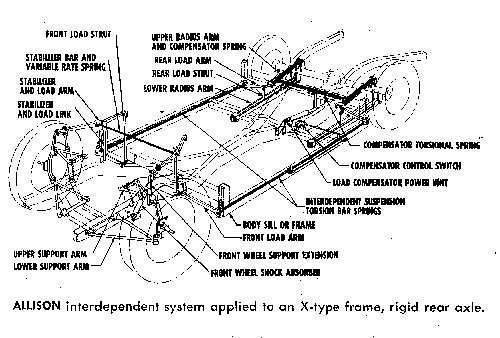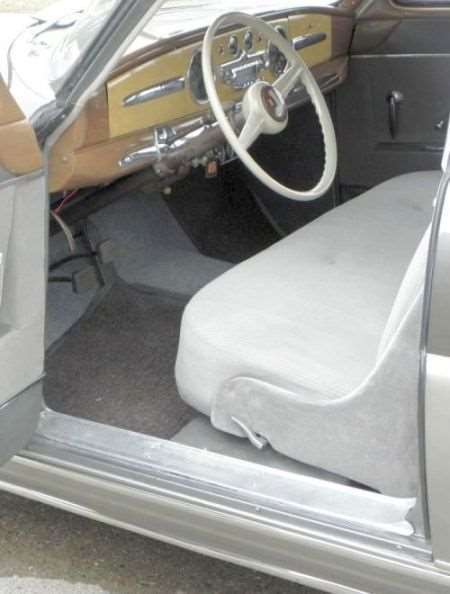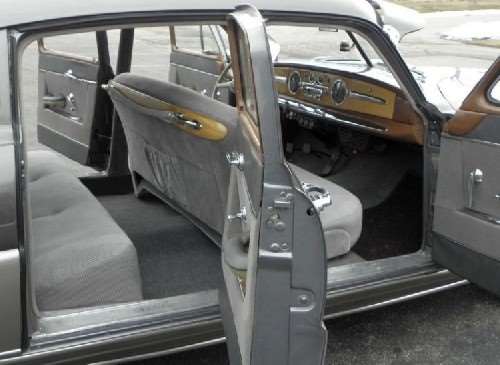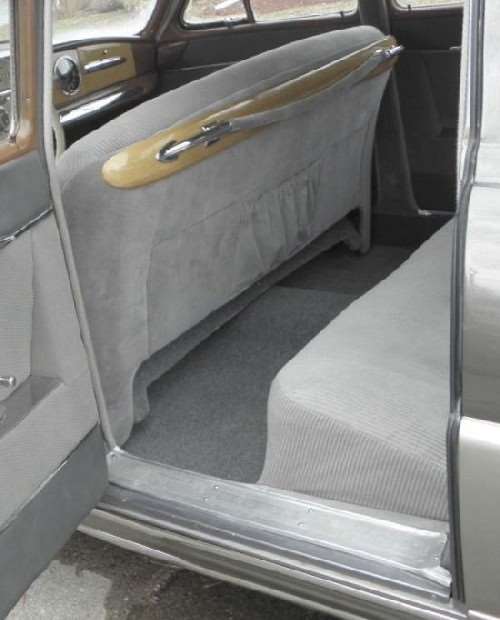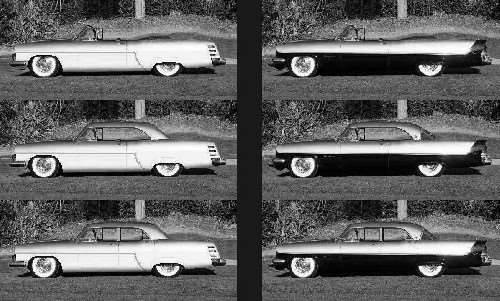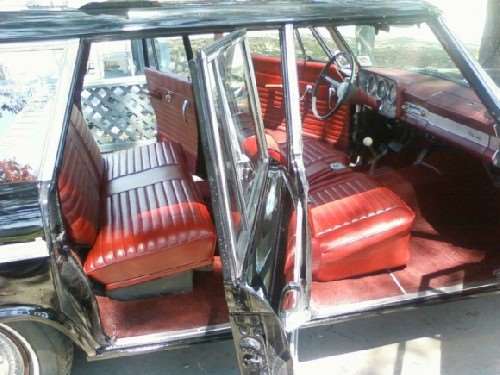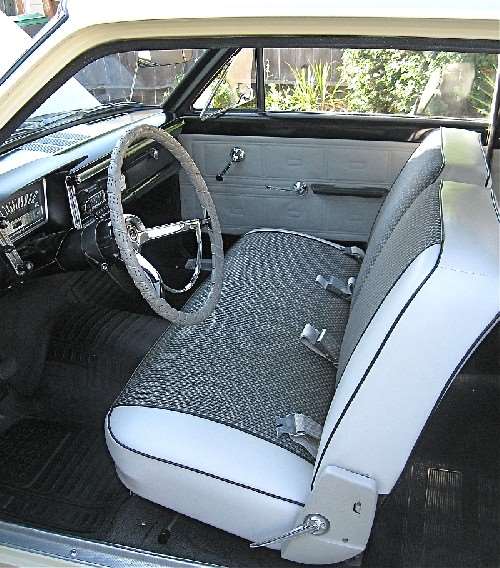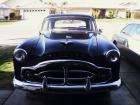|
Re: SP merger
|
||||
|---|---|---|---|---|
|
Home away from home

|
That's very interesting and I guess leads to the obvious question: exactly how was Packard planning to package T-L in the low-slung '57s? Presumably they had something cooked up.
Posted on: 2015/3/21 15:41
|
|||
|
||||
|
Re: SP merger
|
||||
|---|---|---|---|---|
|
Forum Ambassador

|
1957 wheelbases were to be 125 and 130 inches, right?
Posted on: 2015/3/21 16:04
|
|||
|
||||
|
Re: SP merger
|
||||
|---|---|---|---|---|
|
Home away from home

|
Hi
To fit the torsion bar suspension to a revised Step-Down platform, Allison might have had to set aside the interconnected bar concept, instead designed a split bar system: separate sets of bars for front and rear. One problem to overcome was the way the interconnected torsion bars would be installed. At Packard, the suspension components were installed on an inverted chassis frame which more easily allowed loading the full-length bars. The Hudson had a detached front subframe brought together with the body at assembly, that suggest a split bar system installed independently on subframes might have worked best. The cars still would have benefitted from the improved ride and handling as well as the lower-profile available for stylist to exploit. Leafing through memory, I seem to recall that the Step-Down sunken floors were approximately three-four inches below the top of the outer frame members which were more like five-six inches deep....can anyone verify or correct? (Need to find the early SIA article) The attached photos suggest if they were able to run the torsion bars under the floor wells, they would have had scant but sufficient clearance. Attachment points for a split-bar system would have been under the seats as Chrysler did only for the front for 1957. Looking at the Hudson subframe, the front suspension could have been fitted with torsion bars in the same way Packard did. The rear frame section behind the passenger area would have had to have been re-engineered to route the main frame units inside the wheels, allowing a 60" plus rear track, rather than its 55" track. Proportioning for the long Hornet 308 would accommodate the V8 easily, have yielded a nice, long front end which Packard and Hudson should have held onto as part of their identity. Varying mid-section and rear deck lengths would give each make distinct proportions. Although reworking a late 1940's platform to create a new mid-1950's line might seem counter-intuitive, that aging platform had the one advanced feature that would soon become standard industry practice. For Packard-Hudson, it would have been a interim series but what was learned doing it would have carried over well into an all-new 1958 or 1959 body series. In general, the era of the six cylinder medium-priced car was diminishing by 1955-56 but as long as Hudson loyalist kept buying a sufficient number to keep production of the Hornet 308 ci viable, they should have continued to offer them. Until the 320 V8 became the preferred Hudson engine, the Hornet 308's fine reputation should have been capitalize upon. Directing Hudson engineering to develop a high-efficiency OHC six for a new compact/intermediate line in the early 1960's would have been a great diversification move to keep the company profitable. RE: a post-U.S. Jet: Although Hudson and Murray might have been able to peddle the Jet tooling there, to assist their recovering economies European countries had levied high import tariffs to protect their national auto industries still rebuilding after the war. The narrow Jet width would have fit the European roads in most nations better than here. The Jet might also have found a second life in Asia or India which had need for small, economical cars. Latin America seems to have been a best prospect, Kaiser was quite aggressive getting his 'leftover' cars back into production there. Fortuitously, the Henry J tooling went missing before it got there..... Steve PS: my source tells me the all-new 1957's were to have a split bar system with hydraulic leveler, with 125" and 130" wheelbases for different series.
Posted on: 2015/3/21 16:14
|
|||
|
.....epigram time.....
Proud 1953 Clipper Deluxe owner. Thinking about my next Packard, want a Clipper Deluxe Eight, manual shift with overdrive. |
||||
|
||||
|
Re: SP merger
|
||||
|---|---|---|---|---|
|
Home away from home

|
While you guys from Engineering were packaging T-L in the '55s, Studio (that is, a rogue desigenr sitting in the corner) was adding 2-doors.
Went round & round mentally on how to do the hardtop's roof. Use sedan roof? No, too upright and boring. Tool completely different roof/backlight that looks nothing like the sedan? No, would probably end up looking like the rest of the industry. Tool new roof/backlight that carries sedan theme but with 12 degree forward rake at rear? Maybe, float it to management.
Posted on: 2015/3/21 17:22
|
|||
|
||||
|
Re: SP merger
|
||||
|---|---|---|---|---|
|
Home away from home

|
<i>Allison might have had to set aside the interconnected bar concept, instead designed a split bar system: separate sets of bars for front and rear.</i>
Two issues there: splitting the bars eliminates one of the features of TL: upward motion on one wheel is translated to downward load on the other wheel. Instead, a split bar system, while cushioning the shock, would still transmit the force to the body. Second, you can't do variable rate with a torsion bar. Why did Chrysler use leafs in back? You can do variable rate with leaf springs, to compensate for a full gas tank and loaded trunk. <i>I seem to recall that the Step-Down sunken floors were approximately three-four inches below the top of the outer frame members which were more like five-six inches deep....can anyone verify or correct? (Need to find the early SIA article) The attached photos suggest if they were able to run the torsion bars under the floor wells, they would have had scant but sufficient clearance.</i> In the step down's I have looked at, it looked like only a couple inches, but your pix look like it's more. The only way they could clear a full TL system would be to have raised boxes under the seats. In your pix, see how the bottom of the seat is on top of the driveshaft tunnel? I would propose a box under the seat as high as the top of the tunnel, the full width of the body. That would provide room for a cross brace providing lateral rigidity and move the brace above the level of the bars and exhaust pipe. The brace under the front seat would provide the support for the back of the trans and the load leveler system, and the brace under the back seat would provide attachment points for the trailing arms. <i>Directing Hudson engineering to develop a high-efficiency OHC six for a new compact/intermediate line in the early 1960's would have been a great diversification move to keep the company profitable.</i> I wouldn't bother with a new generation 6. I'd keep the 308 only to provide a transition for existing Hudson owners, only as long as the Packard engine bay was long enough to accommodate it. Hudson was a premium brand and 6s were just about dead ducks in that segment by the mid 50s. <i>Fortuitously, the Henry J tooling went missing before it got there.....</i> One of my K-F books says the Henry J tooling was on it's way to the existing Kaiser plant in Israel when it went missing. India would be less accommodating to the Jet as they drive on the wrong side there.
Posted on: 2015/3/21 23:00
|
|||
|
||||
|
Re: SP merger
|
||||
|---|---|---|---|---|
|
Home away from home

|
Great conversation on the T-L, hope the exploration continues. Seems there might have been a package work-around provided the rear footwell height above ground stayed the same as '48-54 step-downs. Of concern would have been overall vehicle height, which needed to be very low for the times to render Chyrsler's '55 overtures to lowness insufficient and to completely demoralize GM and Ford. Hornet and Wasp were 60.4 inches tall and the Hollywood hardtops were less but I can't find a number. The work-ups that I show translate to roughly a 57 inch height. If Hudson's floorpan couldn't drop lower because of T-L, something else would have needed to give such as seat height or headroom. Trade-off studies are part of any new vehicle program so the challenge would have been to develop a balanced plan.
On the Jet, I think Europe needed to be its prime target and the next Jet redesign perhaps needed to include production in Europe, maybe even an engineering and design center. This is of course purely hindsight, knowing the beating the U.S. auto industry eventually took at the hands of M-B, BMW, VW and the Asian competitors. I wonder if clues of what was to come existed at the time. Packard-Hudson would have needed to adopt a global perspective. This was arguably a strength of Mason's. Did Hudson really have a production facility in S. Africa?
Posted on: 2015/3/22 11:13
|
|||
|
||||
|
Re: SP merger
|
||||
|---|---|---|---|---|
|
Home away from home

|
<i>If Hudson's floorpan couldn't drop lower because of T-L, something else would have needed to give such as seat height or headroom.</i>
Everything was being cut to lower rooflines around 60. My dad's 64 Galaxie rolled on dinky, by today's standards, 14" wheels. It had a flat floor in front, but the seats were very low. There were footwells in back, because there was no length for people to stretch their legs out because the front seat was so far back to give it's occupants leg room. To make room for the footwells in back, the exhaust pipe was tucked up next to the drive shaft. Don't touch the inboard front seat belt anchors in a running 64 Galaxie, because the bolt is really hot from only being an inch away from the exhaust pipe. I found that out the hard way. When my mom was shopping for a new car in 64, her big objection to the Olds F-85 was that the seats were so low. "I'm not sitting on the floor!" she said. She ended up with a Rambler Classic, which had footwells deep enough to give her the taller seat she wanted, and still have the lower roof the stylists wanted. Here's a pic of a 63 Studebaker wagon. Studebaker was using a variation of the 53 frame, which did not allow footwells, until they folded the tent, but had to follow the styling trends for a lower roofline. In the front, the seat is very low and forces passengers into an excessively knees up position to fold them up enough to fit. In the back, the seat is higher, to provide more leg room, but at the expense of headroom, so the back seat is kids only.
Posted on: 2015/3/22 12:16
|
|||
|
||||
|
Re: SP merger
|
||||
|---|---|---|---|---|
|
Home away from home

|
In comparison, here's a 63 Rambler Classic, which that 63 Studebaker competed with. Seat is a couple inches higher off the floor and the seat cushion is flatter.
Posted on: 2015/3/22 12:25
|
|||
|
||||
|
Re: SP merger
|
||||
|---|---|---|---|---|
|
Home away from home

|
You hit the nail on the head. I recall seeing a '57 Plymouth in the Chrysler Museum here in Detroit, seemed to have a high rear footwell despite low vehicle height, making for jack knife seating. Better situation once they went to unibody in '60 as this video demonstrates. Note the cut-away drawing at 1:38 minutes... son of a gun if it ain't the Hudson design!
youtube.com/watch?v=ylAeACkNb4U Also note the knee-knocker situation called out at 5:00 minutes into the video. This is where Packard-Hudson would have needed to be careful with that wrapped windshield. I always liked the windshield Chrysler and Studebaker came up with in '55 and absolutely love Chrysler's '57 windshield.
Posted on: 2015/3/22 12:53
|
|||
|
||||

 (145.18 KB)
(145.18 KB)